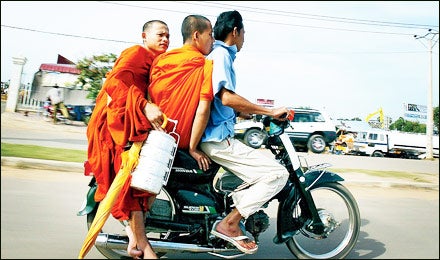A COUPLE of years ago, while living in Cambodia, I stumbled onto a sketchy street on the outskirts of Phnom Penh. My Khmer was good enough for me to understand that the residents really didn’t want me around but not good enough to negotiate a graceful exit. As one woman’s shouts began to elevate, I raised a finger and said the magic word: moto! Three moto-taxi drivers peeled out to my aid. The red Honda in the middle looked fast, so I leaped on and shouted, “Go! Go! Go!” The driver opened the throttle and weaved through pedestrians and cars until we reached the safety of the wider city.
The Little Idea
Naming American Moto-TaxisThey’re variously called tuk-tuks, boda-bodas, and taxi-motos around the world. Help us find a name that’ll click in the States.
That ride left me thinking, Why don’t we have these in the U.S.? They’re more efficient than the Prius, can slip through traffic jams, and don’t require waits at bus stops. And with the average U.S. vehicle occupancy at 1.63 at last count, room for one passenger is more than enough. They’re generally not illegal here, but insurance premiums and traffic laws negate a lot of a moto-taxi’s cost and convenience advantages. That’s a shame when you consider that subsidized buses in most cities are so poorly routed, underused, and burdened with air conditioners that driving a midsize car burns less fuel per passenger.
It’s hard to pin down the impact moto-taxis have on traffic, but it must mean something that, where regulations allow, they tend to proliferate. The Third World cities that rely on them don’t run precise studies, and the European cities, like London and Paris, that have high-end moto-taxi services don’t have enough volume to gauge an effect. Something you can measure, though, is popularity: One Paris moto-taxi operator says the city’s business doubled last year alone. And in any area with bad public transit, they will always catch on. Only, in this country, we won’t let them.
Some of the arguments against moto-taxis are predictable. Americans can’t abide disorder, and the moto-taxi thrives on the chaos of the developing world. Once you get past the extra crowding and honking, though, moto-taxis can help reduce congestion by scavenging the empty bits of pavement between cars. Street-legal moto-taxis in the U.S. would ideally use quiet, clean-burning four-stroke engines┬Ślike cars as opposed to lawnmowers. A ride on one might even seem luxurious. In 1995, billionaire Richard Branson hired a Euro-style moto-taxi and liked it so much that he bought the company┬Śrenaming it Virgin Limobike.
Motorcycles in general have a reputation for being dangerous, which is true when they’re poorly ridden and marginally respected by other drivers. With safety in mind, one French taxi company hires ex-military and former Tour de France motorcyclists┬Śthe guys who carry a cameraman along twisty Alps roads at 60 miles per hour. But anyone who spends all day in the saddle is less likely to have an accident. Limobike general manager Ceri Mort admits it’s a struggle “to deal with people’s misconceptions that we’re going to ride like Evel Knievel.” There’s also long-standing evidence that the more conspicuous motorcycles and riders┬Śand, by extension, moto-taxis┬Śare (reflective clothing, etc.), the more likely it is that drivers will see them and share the road.
A few of the moto-taxi’s shortcomings are less obvious┬Ślike comfort, the weather, and passenger helmet sharing. Virgin Limobike keeps its stable of Yamaha FJR1300’s tricked out with backrests, handles, and a stash of all-weather gear, including a waterproof blanket to protect your shoes. Mort says he also provides a “paper hat thing” for helmets if anyone is wary of lice or hair gel, but helmet sharing, he says, is “no worse than putting your head on an airplane seat.”
In the U.S., moto-taxis face two main obstacles. The first is insurance. When EagleRider, now the largest motorcycle-rental company, initially shopped for insurance, their rates were three times what they’re paying now. The second problem is a traffic law in 37 states that bans “splitting”┬Śthe practice of riding between lanes. Sounds unsafe, but even when allowed, it accounts for only 3 percent of motorcycle fatalities. When it’s outlawed, you’re stuck in crosstown traffic just like everyone else, only you’re breathing exhaust.
In California, there’s no prohibition against splitting lanes. Los Angeles┬Śpay attention, entrepreneurs┬Śhas bad traffic, bad parking, good weather, and a fractured mass-transit system. It also has a city transportation department and taxi commission that are willing to consider just about anything. “Whether it’s the pedicab, the motorcycle concept, the jet pack┬Śyou know those exist, too ┬ů” says Bruce Gillman, spokesman for the L.A. DOT. “Who knows what the future holds?”
If we’re smart, it’ll hold moto-taxis.


